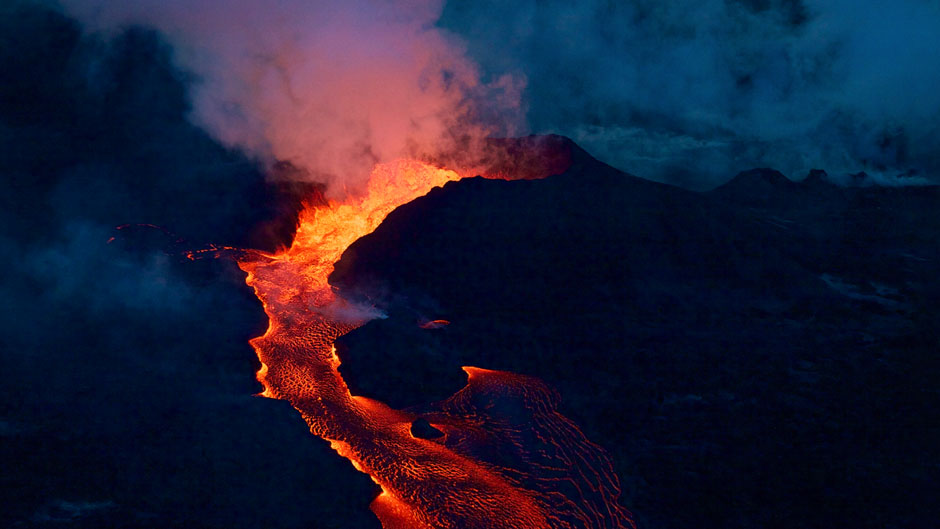One of the hottest spots on Earth during all of 2018 may have owed its fiery, eruptive activity to a cool source that fell from the sky—water.
Hawaii’s Kilauea volcano erupted two years ago on May 3, shooting an ash plume more than 5 1/2 miles into the sky, higher than the cruising altitude of some commercial aircraft.
But unlike most volcanoes that erupt when the pressure in an underground magma chamber increases and fractures the rock around it, allowing lava to escape, Kilauea exploded in a much different fashion, according to a pair of University of Miami researchers. Prolonged and extreme rainfall quite probably reduced the strength of the rock around the magma chamber, giving the molten material a pathway to the surface.
“We knew that changes in the water content in Earth’s crust can trigger earthquakes and landslides, and now we know that it can also trigger volcanic eruptions,” said Falk Amelung, a professor of geophysics at the Rosenstiel School of Marine and Atmospheric Science and co-author of a recent Nature-published and NASA-funded study on how extreme rainfall may have triggered the Kilauea eruption. “Under pressure from magma, wet rock breaks easier than dry rock. It is as simple as that.”
Using data from NASA and JAXA (Japan Aerospace Exploration Agency) satellites, as well as measurements from ground-based rainfall gauges, Amelung and lead investigator Jamie Farquharson modeled fluid pressure deep within Kilauea’s structure over time, finding that the pressure was at its highest point in almost half a century immediately prior to the volcano’s eruption. And, it is that fluid pressure that most likely resulted in magma escaping to the surface, the researchers believe.
“Interestingly, when we investigate Kilauea’s historical eruption record, we see that magmatic intrusions and recorded eruptions are almost twice as likely to occur during the wettest parts of the year,” said Farquharson, an experimental volcanologist and postdoctoral researcher at the Rosenstiel School.
Farquharson has been fascinated by and studying the dynamics of volcanoes since his academic career began at the University of Stirling in Scotland 13 years ago. After he graduated from that institution, he served as an assistant researcher at a volcano observatory in Mexico, analyzing thermal data and taking soil, water, and gas measurements of Colima, that country’s most active volcano.
Along with a group of 12 other researchers, he hiked the flanks of Mount Etna in Sicily for eight days in 2014, exploring its outcrops and deposits even as volcanic activity ramped up at the powerful volcano on each day of their fieldwork. “We had to change plans on the fly,” he recalled, “and every day offered something new.”
He has been to White Island volcano in New Zealand, explored the summit of Colima during one of its less active periods, and surveyed Mount Evermann on the volcanic island of Socorro off the coast of Mexico.
Volcanology, according to Farquharson, is a study unlike any other—safe at times, perilous at others. “It can be dangerous work, and people who do fieldwork around volcanoes are acutely aware of the risks,” he explained. “These are really mountains with deep slopes where rock falls can occur, and that’s not even taking into account that the volcanic activity that can erupt with little to no warning.”
He’s aware of many tragedies in which volcanologists have perished while doing what they loved—simply because they may have been in the wrong place at the wrong time.
But, even though it may mean putting himself at risk at times, it is vital that he studies one of nature’s most powerful forces because getting a better understanding of volcanoes can actually help save lives, because many people, Farquharson pointed out, live in close proximity to volcanoes.
Kilauea, which the U.S. Geological Survey says may top the list of the world’s most active volcanoes, erupted over a four-month period in 2018, spewing enough lava to fill 320,000 Olympic-sized swimming pools, destroying 700 homes and damaging miles of roads.
As climate change continues to affect precipitation patterns around the world, rainfall-induced volcanic activity could become more common, Farquharson noted.
“Most global climate models don’t tend to agree on how much more global precipitation there will be, but they are remarkably consistent in predicting areas where we’ll experience more extreme rainfall,” he said. “This could possibly tell us something. If we can identify regions of the globe where this kind of coupling between rainfall and volcanism exists, it could go a long way towards advanced warning of associated volcanic hazards.”

